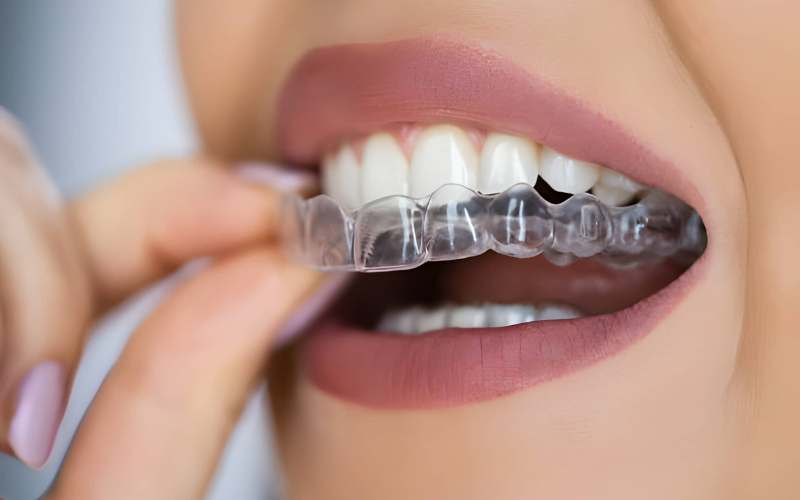A straighter smile isn’t just about looks—it’s about better oral health, too. Clear aligners have changed the way people fix misaligned teeth, offering a discreet and comfortable alternative to braces.
But have you ever wondered what’s really happening beneath the surface?
These aligners don’t just shift teeth; they influence your bite, gums, and overall dental structure.
Before starting treatment, it’s important to understand the effects clear aligners have on your teeth and oral health.
How do they actually move your teeth?
Do they make cleaning easier or harder?
Can they improve your bite?
In this blog, we’ll break down everything you need to know, so you can feel confident about how clear aligners impact your smile and long-term dental health.
How Clear Aligners Affect Your Teeth: The Basics
Clear aligners are a modern and discreet alternative to traditional braces, designed to gradually shift your teeth into better positions. They use controlled, gentle force to move your teeth and gums over time, ensuring minimal discomfort while achieving a beautiful, straight smile.
- Clear aligners apply precise pressure to specific teeth, guiding them into alignment.
- They are custom-made to fit snugly over your teeth and are changed periodically to maintain gradual movement.
- Unlike braces, which are fixed, aligners are removable, allowing you to eat, drink, and clean your teeth without restrictions.
- The process is typically faster than traditional braces, offering flexibility and comfort.
3. Improved Oral Hygiene with Clear Aligners
One of the biggest advantages of clear aligners is the ability to maintain excellent oral hygiene throughout your treatment. Since aligners are removable, you can brush and floss your teeth like normal, ensuring that food particles and plaque don’t build up.
- No need for special tools to clean around brackets or wires, unlike traditional braces.
- You can remove aligners when eating or drinking, which helps avoid food getting stuck and contributing to plaque buildup.
- Regular brushing and flossing prevent cavities, gingivitis, and tooth decay, making aligners a great option for those concerned about oral health.
- This removability also reduces the risk of bad breath and other hygiene-related issues often seen with traditional braces.
4. Reducing the Risk of Gum Disease
When teeth are misaligned, they can create hard-to-reach spots where food and plaque accumulate. Over time, this can lead to gum disease, as the gums become irritated and inflamed. Clear aligners help prevent these issues by gradually improving your teeth alignment.
- Misaligned teeth often trap food and bacteria, leading to plaque buildup and gum irritation.
- Clear aligners allow for easier cleaning, reducing the risk of gum disease and related issues like swelling and bleeding gums.
- By aligning teeth properly, aligners create a healthier foundation for your gums, promoting long-term oral health.
- Better alignment can also make it easier to maintain healthy gums and avoid the need for more complex treatments down the road.
5. The Impact on Bite and Jaw Health
Clear aligners not only straighten your teeth but also play a crucial role in improving bite alignment. A proper bite can reduce strain on your jaw and improve overall comfort, making your daily life easier.
- Misaligned bites, or malocclusion, can lead to unnecessary strain on the jaw, causing discomfort and tension.
- Aligners correct bite issues such as overbites, underbites, and crossbites, promoting better jaw function.
- With a balanced bite, you’re less likely to experience TMJ disorders, which can cause pain and difficulty in moving your jaw.
- Clear aligners make it possible to correct bite problems without the discomfort often associated with traditional braces.
6. Potential Challenges
While clear aligners offer numerous benefits, there are a few challenges that some people experience. These can range from minor discomfort to difficulties in consistency with wear. However, with proper care, these challenges can be managed.
- Some discomfort may occur as teeth shift, especially when you switch to a new set of aligners.
- Speech may be temporarily affected as you get used to wearing aligners.
- Keeping track of wearing aligners for the recommended 20-22 hours a day can be challenging, but consistency is key for optimal results.
- Regular follow-up visits with your dentist ensure you stay on track and address any concerns that arise during treatment.
7. Long-Term Benefits for Oral Health Post-Treatment
Once your clear aligner treatment is complete, the benefits extend well beyond just a straight smile. The long-term effects on your oral health can significantly improve your overall dental well-being.
- Well-aligned teeth are easier to clean and maintain, reducing the risk of tooth decay and gum disease.
- Aligners help in preventing tooth wear by ensuring proper bite alignment, which reduces uneven wear on teeth.
- After treatment, wearing a retainer ensures that your teeth stay in their new positions, maintaining the results achieved.
- Retainers help protect the investment you’ve made in your oral health and prevent future alignment issues from developing.
Clear aligners offer a game-changing solution for those seeking a straighter smile and improved oral health. With benefits like better hygiene, reduced risk of gum disease, and jaw relief, they make dental care easier and more effective. So, if you’re considering aligners, rest assured that they’re not just about aesthetics—they’re about a healthier, more comfortable smile for years to come.

